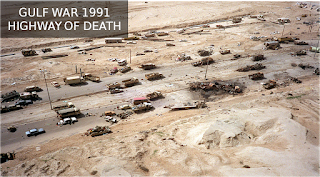Immediate Pre-Gulf War Era (1990-91)
This period marked the
- end of communism,
- the breakup of the Warsaw Pact,
- the dissolution of the Soviet Republic,
- the rise of Yeltsin, and
- formation of the Russian Federation.
Gorbachev announced unilateral force reductions in Europe in 1989. The Soviet military began a move toward professionalism versus conscription. Force development began to focus on qualitative factors rather than quantitative ones. The political factions reassessed the military threat from the West after force reductions and declared them less threatening. The Soviets doctrinal evolution plate was overflowing.
The central theme of doctrine evolution during this period was how to make "defensive doctrine" and "reasonable sufficiency" work after military restructuring. According to Lester Grau of the Foreign Military Studies Office, many indicators show the declaration of a defensive doctrine was
"a purely political decision made for economic and political purposes and imposed on the military with little regard for the military logic of that doctrine."He points out that Soviet professional books and journal articles after the new doctrine declaration continued to reflect the Soviet military's conservative approach to operational art. Suddenly, the Soviets found themselves on a trip down the Yellow Brick Road, where perceptions and reality would come into sharp conflict.
The Soviet's view of the future battlefield emphasized nonlinearity. Their fielding systems optimized for deep battle peaked just before Gorbachev became General Secretary. New U.S. and NATO systems were clearly a generation ahead of those of the Soviets. The role of precision-guided munitions and electronic warfare had added a great combat additive to NATO forces. The Soviets were clearly behind; however, they did not intend simply to mirror image NATO's reliance on technology as a force multiplier. Soviet military professionals asserted they,
"will not follow in the wake of the probable enemy and copy his weapons and employment concepts rather it intends to seek asymmetrical solutions, combining high combat effectiveness with economic efficiency."The Soviet forces "are to become equipped with the latest in science and technology and become increasingly more flexible, cohesive, and mobile."
The revamped force structure was compact and ready, and easily expandable by an enhanced mobilization base. Finally, the restructured force relied on "fully automated command, control, communications infrastructure to facilitate mission execution. The Soviets hoped the synergy produced by these force structure factors would amount to an order of magnitude increase in combat effectiveness.
The Soviet's vision of the future battlefield was of a high intensity, dynamic, high tempo, air-land operation extending over vast land area and space. It orchestrated positional elements, preplanned fires, maneuverable fire elements, counterattack forces, and counterstrike forces. Maneuver defense using security zones and covering forces provided operational and tactical depth to the defense. Maneuver and counter-maneuver forces ensured the defense was viable and created conditions favorable to a counteroffensive. Tempo allowed the Soviets to use tactical units to counterattack into the operational depth of the enemy during operational/strategic counteroffensives.
An interesting characteristic of this doctrine is common to all Soviet military doctrine. The defense creates a favorable condition to culminate in an offensive. In this regard, the forces allotted to the defense were secondary to that of the counteroffensive and operational reserves exploited the counteroffensive. More than just blunting an attack, the defense became the means to seize the initiative from the aggressor. It also created the conditions that would ultimately lead to defeating the enemy. Key to seizing initiative is counterstrike and preemption. Although this period became one of how to apply "defensive doctrine," it is interesting that maintaining offensive capability was the essence of this defensive doctrine. The forces necessary to carry out this doctrine become very similar to those contained in the Brezhnev military doctrine. The primary difference was a smaller, faster, more concentrated force structure. One can, therefore, view the ideas of "strategic defensive" and counteroffensive as the same doctrinal concept.
 |
| May 9, 2016, photo, Russian soldiers march during the Victory Day military the parade marking 71 years after the victory in WWII in Red Square in Moscow, Russia |
Throughout its evolution, Russian military doctrine took on certain primary characteristics. It took many forms and descriptions. But in looking at the doctrine closely, we see a persistent and recurrent theme involving offensive action. One can build a stereotype of the general characteristics of this doctrine. As the air phase of the Gulf War began in January 1991, this is the doctrinal template the Russians applied. It was the comparative paradigm they applied to measure Western military performance against their forty-year-old ideas about the nature of future war. It was this stereotypical doctrinal idea they used to "click their heels together" to carry their offensive force structure wherever they wished their military strategy to go.


.jpg)

No comments:
Post a Comment